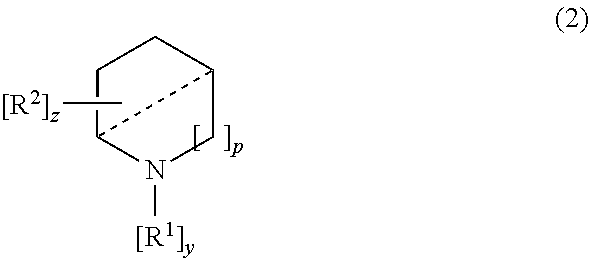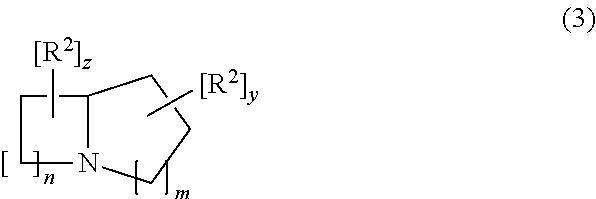Treatment of lysosomal storage disorders and other proteostatic diseases
- Summary
- Abstract
- Description
- Claims
- Application Information
AI Technical Summary
Benefits of technology
Problems solved by technology
Method used
Image
Examples
example 1
Identification of Pharmacoperones for α-Mannosidase
[0716]Solutions of 0.2M Mcllvane buffer at pH 4.5 and 5 mM p-nitrophenyl-α-D-mannopyranoside (Sigma, N2127), dissolved in the buffer, were prepared. A solution of Jack bean α-D-mannosidase enzyme (Sigma, M7257, 22 Units / mg, 6.2 mg / ml.) was also prepared at 0.6 Units / ml in the buffer.
[0717]The incubation mixture consisted of 10 μl enzyme solution, 10 μl of 1 mg / ml aqueous iminosugar solution and 50 μl of 5 mM substrate made up in buffer at the optimum pH for the enzyme. The reactions were stopped by addition of 70 μl 0.4M glycine (pH 10.4) during the exponential phase of the reaction, which had been determined at the beginning using uninhibited assays in which water replaced inhibitor. Final absorbances were read at 405 nm using a Versamax microplate reader (Molecular Devices). Assays were carried out in triplicate, and the values given are means of the three replicates. Results were expressed as a percentage of uninhibited assays in...
example 2
Identification of Pharmacoperones for Other Glycosidases
[0721]The inventors have also observed stimulation of other glycosidase activities such as α-glucosidase, α-galactosidase and hexosaminidases by a range of other iminosugars without them being inhibitory to other glycosidases. Such compounds might therefore have utility in diseases such as Pompe's disease, Sandhoffs and Fabry's for example.
[0722]The assays were conducted as described by Watson et al. 1997, Phytochemistry 46: 255-259 using p-nitrophenyl-substrates. Assays were carried out in microtitre plates. Enzymes were assayed in 0.1M citric acid / 0.2M di-sodium hydrogen phosphate (Mcllvaine) buffers at the optimum pH for the enzyme. All assays were carried out at 20° C. All enzymes and substrates were purchased from Sigma Aldrich Chemicals Limited. The incubation mixture consisted of 10 μl of enzyme solution, 10 μl of the iminosugars solution (made up in deionised water at 5 mM) and 50 μl of the appropriate 5 mM p-nitropheny...
example 3
Identification of Pharmacoperones that Bind to the Catalytic Site
[0724]The compounds of the invention can also function as chaperones through being specific inhibitors of glycosidases that are deficient in lysosomal storage disorders. An example is Compound 56 which potently inhibited alpha-L-iduronidase but none of the other 14 glycosidases described in Example 2. This compound, for example, might therefore show therapeutic activity for mucopolysaccharidosis type 1. Similarly Compound 7 is a specific inhibitor of beta-glucuronidase and might therefore be a treatment for mucopolysaccharidosis VII.
PUM
| Property | Measurement | Unit |
|---|---|---|
| Fraction | aaaaa | aaaaa |
| Fraction | aaaaa | aaaaa |
| Fraction | aaaaa | aaaaa |
Abstract
Description
Claims
Application Information
 Login to View More
Login to View More - R&D
- Intellectual Property
- Life Sciences
- Materials
- Tech Scout
- Unparalleled Data Quality
- Higher Quality Content
- 60% Fewer Hallucinations
Browse by: Latest US Patents, China's latest patents, Technical Efficacy Thesaurus, Application Domain, Technology Topic, Popular Technical Reports.
© 2025 PatSnap. All rights reserved.Legal|Privacy policy|Modern Slavery Act Transparency Statement|Sitemap|About US| Contact US: help@patsnap.com



